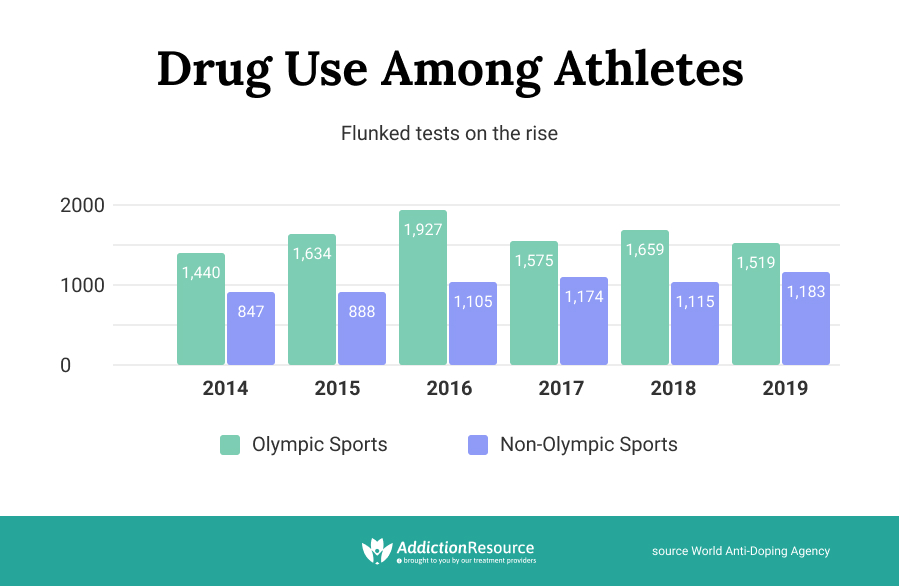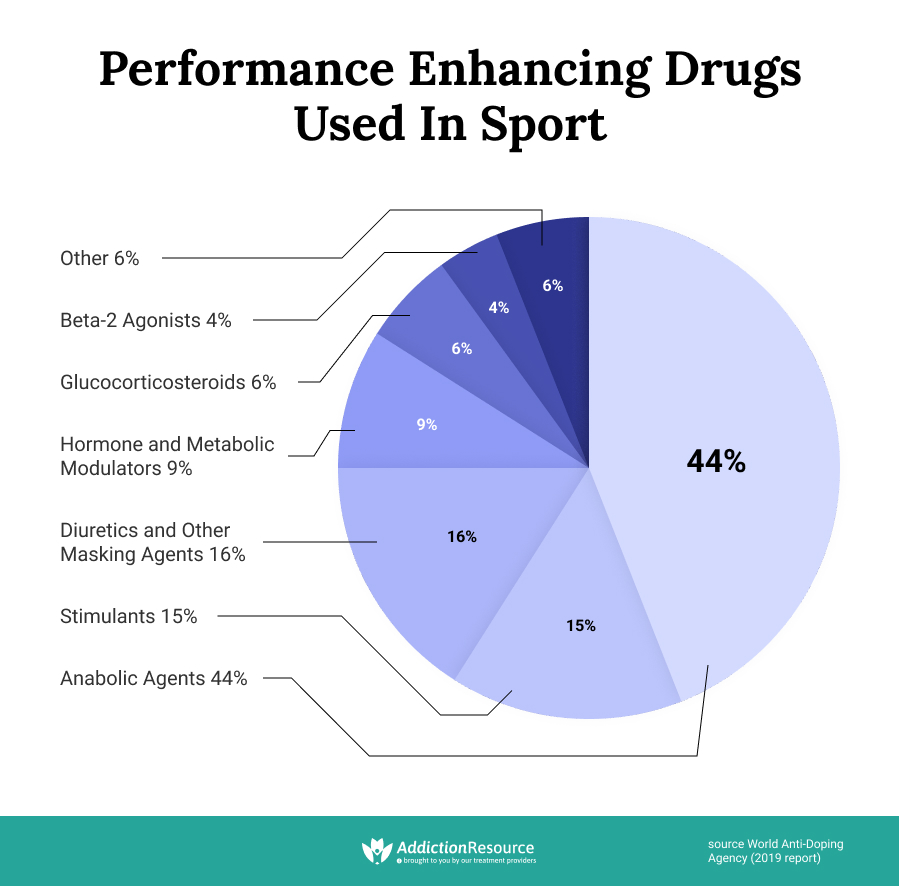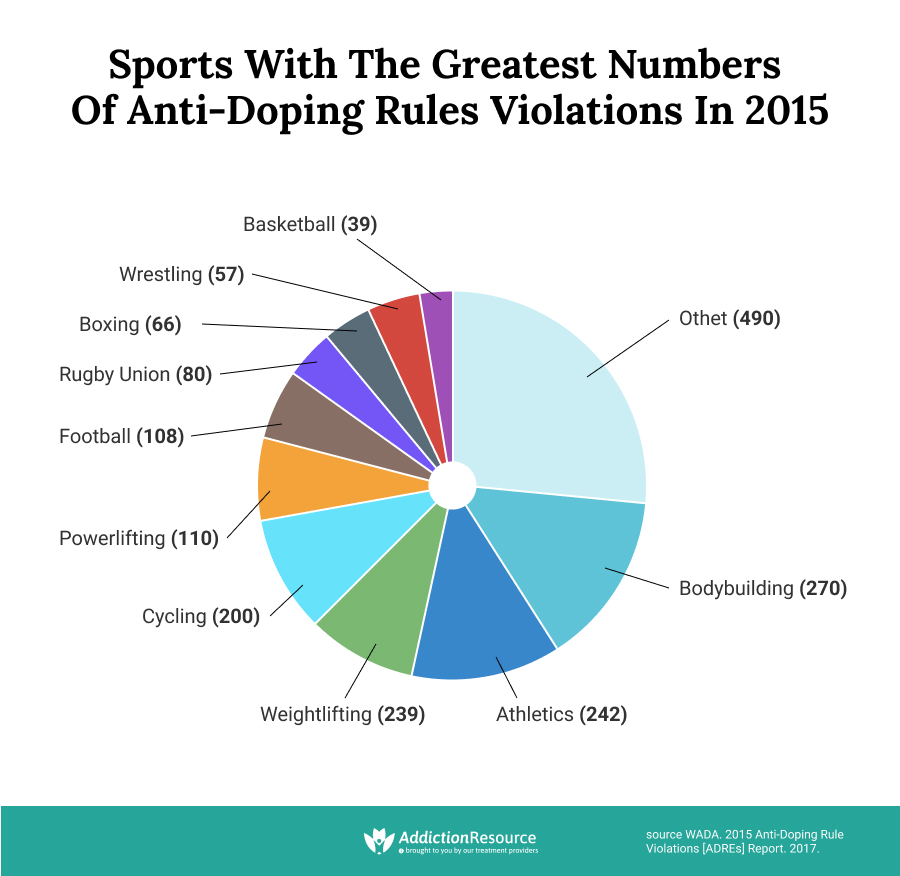Athletics are inherently competitive. If an athlete is not competing with someone else, they are competing with who they were yesterday, striving to do better, to be better. And the pressure to improve is not merely internal; from coaches to parents to fans, it seems that everyone around athletes pushes them to do more and be more.
Table Of Contents:
- What Are Performance-Enhancing Drugs?
- Which Other Drugs Are Used?
- What Reasons Do Athletes Have for Using These Substances?
- What Are the Types of PEDs?
- What Are the Key Moments in Doping History?
- Is It Possible to Get Addicted to PEDs?
- What Are the Signs of Addiction?
- How Can Athletes Get Help for Addiction?
- How to Prevent the Use of PEDs?

While they often seem supernatural in their abilities, athletes are human, and humans have their limitations. So how do athletes handle the conflict between pressure to improve and their own limitations? Is there a prevalence of drugs in sport?
Performance Enhancing Drugs
Performance-enhancing drugs (PEDs) are substances used to improve physical ability, notorious for their illegal use in athletic competitions. While these substances may not be illegal in general use, their clandestine use in sports, known as doping, is commonly prohibited.
The history behind drug use in sports goes as far back as ancient times, claiming that doping might have been present as far back as the ancient Olympic Games. However, in relatively more modern times, one of the earliest records of doping was during an endurance walking race where a contestant admitted to using opiates to stay alert.
Such endurance races eventually increased in popularity to the extent where participants stood to win rather impressive prizes. It proved to be a worthy incentive for the athletes to consume substances to improve their performance, even with the side effects that many of them caused, such as psychosis.
Anabolic steroids, used to improve the ease and efficiency of building muscle, became a mainstay among weightlifters and bodybuilders in the 20th century.

The health risks of drug abuse in athletes and the unfair advantage experienced by them were significant enough to induce the formation of the World Anti-Doping Agency in 1999.
The use of PEDs has increased in recent years. However, this is largely due to the availability of more options, many of which feel safer to athletes than traditional drugs. While the idea of injecting steroids may have seemed off-putting to all but the most driven athletes, taking a supplement that can be purchased at any health store seems less risky or even normal. And doing so is socially acceptable. As a result, up to 12 percent of teens, both engaged in sport and not, use substances to improve performance and appearance. While women use these substances as well, their use is more prevalent amongst men.
Although the medical concern is most significant for teens abusing drugs like PEDs, that is generally not where the media focuses. Instead, the media and the public are most concerned with doping in major league sports. Both Major League Baseball and the National Football League have seen significant controversy in recent years related to players’ drug use in sports. The current conversation around the practice can be traced back to the revelation of steroid use in MLB players back in the late 90s to early 2000s. More than 24 MLB suspensions have been related to performance-enhancing drugs since 2005; on the NFL side, hundreds of games have been missed due to temporary suspensions related to doping.
Side Effects Of Performance Enhancing Drugs
There are several kinds of performance-enhancing drugs in sport. Essentially all of these substances have side effects, even the ones which are found naturally in the body.
Anabolic steroids are used to increase muscle growth. However, these drugs can cause breast growth, prostate gland enlargement, smaller testicles, and infertility in men. Women may become more masculine, with a deeper voice, more body hair, baldness, and infrequent menstruation. Drug dependence, aggressive behavior, and psychiatric disorders are also possibilities, among many more.

Other performance-enhancing drugs, such as human growth hormone, erythropoietin, and stimulants, can cause an array of adverse effects. These effects include many severe cardiovascular reactions, such as hypertension, reduced blood pressure, pulmonary embolism, stroke, enlargement of the heart, and heart attack.
Other Drug Use Among Athletes
While the drive to perform at their very best pushes athletes to use drugs in sport, they face other factors that can cause different kinds of drug abuse.
They have to perform on large stages, with many people’s expectations resting on them. This pressure predisposes them to mental health conditions such as anxiety, stress, and depression. It can result in drug abuse in athletes, of medications like anxiolytics and antidepressants.
Besides prescription medication, many athletes may turn to illicit substances to deal with mental health conditions, stressors, and pain that they experience.
Information from one study showed that more than four out of every five student-athletes who participated in the survey admitted to using alcohol. About a third of them stated that they use marijuana in any form.
However, most of them indicated their use was for social purposes and not anything relating to sports.
A study performed among young elite athletes in Italy provided interesting information showing that the most used illicit drug among athletes is cannabis. However, it was only seen in 0.2 to 0.4% of samples tested. Following that was cocaine, in 0.1% of samples.
The information from a 2020 study among professional athletes demonstrated opioid use in under 5% of participants in the study.
Causes Of Drug Abuse in Athletes
As with any drug use, the exact reasons an athlete turns to drugs in sport are personal. However, a common factor is—as one would assume—improved performance and physical condition.
However, it is essential to keep in mind that athletes may also use illicit drugs for recreational purposes in addition to their PEDs, similar to non-athletes. It means that athletes have two different avenues of drug use in sports.
Why Do Athletes Use PEDs?
- The drive to win. Every athlete has a moment where a win can change their life, and a loss could be the end of their career. Some sporting moments are remembered for decades. For professional athletes, sports are not about fun; but about winning. There is little care given to the cost of reaching that goal in many cases.
- The athletic physical form. In most sports, physique matters only as far as it helps performance. However, bulking is critical in some sports because appearance or physical form is central to winning. The most notable is bodybuilding, with the PED most often used being anabolic steroids. Approximately 19 percent of bodybuilders acknowledge steroid use; studies that do not rely on self-reporting are likely to see higher results. However, many other drugs are used as an alternative or in addition to this drug use in sports. In some cases, they may be unaware they are using steroids. Many supplements designed for bodybuilders contain steroids that are not on the packaging.
- The future at large. Many young people who use PEDs are concerned for their future. For many student-athletes, an athletic scholarship is the only choice for a college education. High performance is needed before admission and throughout college to maintain the scholarship. College tuition continues to rise, so these scholarships are even more vital. 35% of jobs require a minimum of a bachelor’s degree, with only 36% accepting a high school diploma or less, and most do not pay living wages. Many young athletes feel pushed towards performance-enhancing drug use in sports as a result.
What Are the Different Types of Performance Enhancing Drugs?
Steroids are easily the most well-known type of doping drug; however, they are not the only type. They are not even the most commonly used performance-enhancing drug; instead, general supplements are, with creatine leading the pack. The consequences of use—both physically and within the sports world—vary depending on the drug used.

Below are some of the most commonly used types of performance-enhancing drugs:
Anabolic Steroids
Anabolic steroids are synthetic drugs that mimic or enhance the effects of testosterone. They encourage muscle growth. In medical settings, they can be used to treat muscle loss and delay the onset of puberty. Anabolic steroids can affect sex hormone production in men, resulting in shrunken testicles, infertility, gynecomastia, and prostate enlargement. In women, they will begin to develop ‘manly’ features such as baldness, more body hair, and a bigger clitoris.
General side effects include acne, inhibited growth in teenagers, hypertension, liver tumors, and psychiatric disorders.
Stimulants
Stimulants are drugs that act on the central nervous system by speeding up physical processes. It can mean increased heart rate and blood flow and elevated body temperature. Drug abuse in athletes covers both legal, illegal, and prescription stimulants. Some examples include amphetamines, cocaine, and even nicotine. Stimulants may negatively affect physical performance, however. This is due to side effects such as dehydration, heatstroke, and nervousness. Addiction to stimulants can also occur, along with tolerance.
Human Growth Hormone
Human growth hormone naturally occurs within the body. However, synthetic versions have become very popular within the world of sports. When it occurs naturally, it helps teens grow their bones during puberty and strengthen the skeletal structure overall; in medical settings, it can be used to help those who are not producing enough during puberty or who are fighting certain diseases, such as HIV. However, it is used in sports for another reason.
Diabetes, visual disturbances, hypertension, joint pain, and cardiomegaly can occur due to abuse of this prescription medication.
Erythropoietin
Erythropoietin is a hormone produced by the kidneys in response to insufficient oxygen in the body cells. It functions by stimulating the production of red blood cells in the bone marrow. In medical settings, it is used to treat anemia. This substance increases how much oxygen the muscles get, which helps keep them non-fatigued and primed.
This is one of the substances that can demonstrate the health risks of drug abuse in sports. For example, in the 90s, several cyclists died due to this drug, which increases the risk of cardiovascular conditions such as heart attack and pulmonary embolism.
Blood Doping
Blood doping is a practice whereby athletes receive blood transfusions or use synthetic oxygen carriers to increase their blood’s oxygen-carrying capacity. This equates the more oxygen for the muscles, which comes with a performance boost. While the athlete’s own blood can be used if stored ahead of time, same-type blood from a third party is also an option.
Blood doping can present the athlete with the risk of diseases such as HIV, hepatitis B, and C. Even with the athlete’s blood, there are still risks, such as blood clots, stroke, and heart attack.
Beta-Blockers
The anxiolytic effect of beta-blockers is what makes them abused as PEDs. Athletes who rely on being steady or stable in their sport, such as archers, shooters, dart players, and others, may turn to drug abuse in sports with beta-blockers like propranolol. It does not affect the actual mental anxiety but takes care of the physical manifestations. Side effects of these drugs include dizziness, cold extremities, insomnia, heart failure, and liver abnormalities.
In addition to these drugs, there are thousands of supplements on the market that can enhance performance. Some of these are banned by professional associations while others are allowed, and others still are being studied.
Diuretics
Diuretics are medications that induce fluid loss from the body through urination. Reducing the water volume in the body can significantly reduce weight, which is why this drug abuse in sports appeals to some athletes. Producing more urine also helps dilute any drug metabolites which may be in the urine, which is why some athletes use it for masking illegal substances in their urine. However, diuretics can predispose to dehydration, dizziness, hypotension, cramps, and even death.
The Battle Against Doping in Sports
Ever since doping in sports has been known to exist, efforts have been made to deter it. However, these efforts did not become mainstream until the last 30 years. During this time, significant measures have been taken to punish the use of performance-enhancing drugs, deter athletes from starting them, and improve testing methods.
- On August 26, 1960, doping in sports became an international topic when Knut Jensen died during the Olympic games in Rome. His death was linked to the use of amphetamines.
- In 1967, after a high-profile Tour de France doping death, the International Olympic Committee established a commission to fight drugs in sport.
- In 1968, the International Olympic Committee began drug testing athletes. This is also the first year an athlete was disqualified for Olympic performance due to doping.
- On September 27, 1988, Ben Johnson became the first athlete to be stripped of an Olympic medal due to a positive doping test.
- On October 5, 1990, the United States Congress passed the Anabolic Steroids Control Act.
- On November 10, 1999, the World Anti-Doping Agency was established.
- On October 1, 2000, the United States began operating its anti-doping agency called the US Anti-Doping Agency.
- In 2004, the World Anti-Doping Agency took over the list of banned substances for the International Olympic Committee.
- On August 4, 2011, the National Football League became the first US sports agency to make random blood tests mandatory.
- In August of 2011, the first suspensions of Major League Baseball players for using human growth hormone occurred.
- On August 23, 2012, Lance Armstrong was stripped of all his Tour de France titles due to doping.
- In January 2013, many players in MLB were found to be doping with the aid of human growth hormone and other substances. Over 12 players were suspended for 50 matches.
- In December 2019, Russia received a two-year ban from applicable competitions due to a state-sponsored doping scandal which was uncovered.
- On July 2, 2021, Sha’Carri Richardson was suspended for a month during the Olympics for a positive test for marijuana in a sample previously collected.
Drug Test For Athletes
Drug abuse in sports can be tested through urine, blood, saliva, and hair samples. However, blood and urine tests are the most common. The samples can be tested using chromatography, immunologic assay, and mass spectrometry. The exact test used will depend on what types of substances are being checked for and the policies of the league doing the testing.

For example, anabolic steroids and their byproducts are detected in urine samples examined using a combination of gas chromatography and mass spectrometry; each league determines the allowable testosterone levels, given that it is naturally occurring, and anything above that threshold is deemed to be doping. Likewise, human growth hormone is tested in two steps: a urine test to show current presence and a blood test to prove the use of HGH over time.
Can these tests be cheated? Yes, and many athletes have. But the exact methods for cheating them are constantly evolving as the testing process changes. As a result, there is no perfect guide to passing a doping test while still using performance-enhancing drugs in sport.
Drugs In Sport and Addiction
Drug abuse in athletes lays the foundation for the development of addiction, which can happen. For anabolic steroids, this is referred to as steroid use disorder. They may also develop an addiction to stimulant medications such as Ritalin, amphetamines, and illicit drugs like ecstasy and cocaine. An athlete’s sources for PEDs may extend their supply to include other forms of illegal substances.
Addiction may also develop following sports injuries. This has athletes prescribed opioid analgesics. The danger here is that an athlete may not want to wait several weeks, or even months, to get back to their sport. Instead, they may continue using the opioids so they can handle the pain they’d otherwise be facing during games. This is one way that athletes addicted to painkillers come about.
The pressure that comes with being a competitive athlete with a team, fans, and family behind them can be intense, and in many cases, can prompt the abuse of alcohol or drugs in sport. It may reach an extent where the athlete abuses the drug every day to help cope.
Athletes On Drugs: Symptoms and Signs
The signs that will stem from drug abuse in athletes depend on the specific drug the athlete abuses. Stimulants and steroids will not have the same profile of symptoms and signs.
Signs of Drug Abuse Include:
- New or increased acne
- Increased muscle mass
- Deepening of the voice in females
- Excessive body hair in females
- Depression
- Increased appetite
- General agitation
- Anxiety
- General swelling
Additionally, sudden secrecy, strange habits, and missing money are all signals that someone may have a drug problem, whether it involves PEDs or not.
Help For Drug Use In Sports
When athletes on drugs are looking for information on substance abuse treatment, confidentiality tends to be one of their biggest considerations. They would not want any harm to be done to their career prospects.
Athletes on drugs are likely to need a facility that provides amenities that allow them to remain active, such as a gym or a swimming pool. Their dietary needs are also important.
The best form of rehab for such patients is likely to be a luxury center as their requirements can be catered for best in such a center. However, it is possible that some regular centers provide the amenities desired.
It is important for athletes who use drugs in sports to seek help as soon as possible, as a drug test for athletes is a regular occurrence, and one random test could severely affect their reputation.
How to Prevent the Use of Performance Enhancing Drugs
Current anti-doping measures rely primarily upon the punishment of athletes who use performance-enhancing drugs. The effectiveness of this is hotly debated, given that many athletes still use these drugs despite the potential consequences. It makes it clear that there is more to be done.
In younger athletes, disapproval from those closest to them helps deter their use of drugs in sport more than any other barrier. A focus on education and helping these athletes see their potential without drugs in sports is vital to keeping them clean. It is also essential to establish a moral framework that helps the athlete see that doping isn’t the right choice, even if others are doing it.
Because preventing performance-enhancing drug use is so difficult, there is now a movement within athletics to simply allow doping. However, this is problematic because it does not acknowledge the impact such a decision will have on the health of the athletes who engage in doping. For now, it would seem that the best approach is to discourage use and be there to help those who fall into the trap of using performance-enhancing drugs in sports.
Frequently Asked Questions
Should Professional Athletes Be Drug Tested?
Professional athletes are already drug tested regularly, with random drug tests being the most common form of carrying this out. The benefit to these random drug tests is that it prevents athletes on drugs from cheating the system if they are unaware of when testing is happening.
How Many Professional Athletes Use Steroids?
Though there is a notion that a relatively large percentage of athletes use anabolic steroids, studies have shown it to be rare, and under 6% of professional athletes. However, information from an Iranian study showed an interesting difference with a value of 36.2% among athletes. It shows that there may be significant geographical variance.
Is Testosterone a Performance-Enhancing Drug?
Testosterone is a performance-enhancing drug. It is an anabolic steroid, and in fact, most anabolic steroids misused by athletes are synthetic variants of testosterone. Some athletes choose to use pure testosterone.
Hope Without Commitment
Find the best treatment options. Call our free and confidential helpline
Most private insurances accepted
Page Sources
- Sundgot-Borgen, J., & Torstveit, M. K. (2004). Prevalence of eating disorders in elite athletes is higher than in the general population. Clinical journal of sport medicine : official journal of the Canadian Academy of Sport Medicine, 14(1), 25–32. https://pubmed.ncbi.nlm.nih.gov/14712163/
- Reardon, C. L., & Creado, S. (2014). Drug abuse in athletes. Substance abuse and rehabilitation, 5, 95–105. https://www.ncbi.nlm.nih.gov/pmc/articles/PMC4140700/
- Castaldelli-Maia, J. M., Gallinaro, J., Falcão, R. S., Gouttebarge, V., Hitchcock, M. E., Hainline, B., Reardon, C. L., & Stull, T. (2019). Mental health symptoms and disorders in elite athletes: a systematic review on cultural influencers and barriers to athletes seeking treatment. British journal of sports medicine, 53(11), 707–721. https://bjsm.bmj.com/content/53/11/707
- World Anti-Doping Agency, 2019 Anti-Doping Testing Figures, https://www.wada-ama.org/sites/default/files/resources/files/2019_anti-doping_testing_figures_en.pdf
- Kumar R., Competing against doping, British Journal of Sports Medicine, 2010;44:i8. https://bjsm.bmj.com/content/44/Suppl_1/i8.3
- National Institute on Drug Abuse, Are anabolic steroids addictive, 2018, https://www.drugabuse.gov/publications/research-reports/steroids-other-appearance-performance-enhancing-drugs-apeds/are-anabolic-steroids-addictive
- Brisola-Santos, M. B., Gallinaro, J. G., Gil, F., Sampaio-Junior, B., Marin, M. C., de Andrade, A. G., Richter, K. P., Glick, I. D., Baltieri, D. A., & Castaldelli-Maia, J. M. (2016). Prevalence and correlates of cannabis use among athletes-A systematic review. The American journal on addictions, 25(7), 518–528. https://pubmed.ncbi.nlm.nih.gov/27629700/
- Strano Rossi, S., & Botrè, F. (2011). Prevalence of illicit drug use among the Italian athlete population with special attention on drugs of abuse: a 10-year review. Journal of sports sciences, 29(5), 471–476. https://pubmed.ncbi.nlm.nih.gov/21279865/
- Ekhtiari, S., Yusuf, I., AlMakadma, Y., MacDonald, A., Leroux, T., & Khan, M. (2020). Opioid Use in Athletes: A Systematic Review. Sports health, 12(6), 534–539. https://journals.sagepub.com/doi/abs/10.1177/1941738120933542
- Berning, J. M., Adams, K. J., & Stamford, B. A. (2004). Anabolic steroid usage in athletics: facts, fiction, and public relations. Journal of strength and conditioning research, 18(4), 908–917. https://pubmed.ncbi.nlm.nih.gov/15574100/
- Selk-Ghaffari, M., Shab-Bidar, S., & Halabchi, F. (2021). The Prevalence of Anabolic-Androgenic Steroid Misuse in Iranian Athletes: A Systematic Review and Meta-Analysis. Iranian journal of public health, 50(6), 1120–1134. https://www.ncbi.nlm.nih.gov/pmc/articles/PMC8410978/

 Authored by
Authored by  Reviewed by
Reviewed by